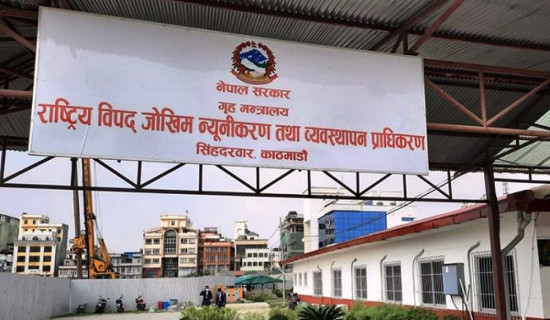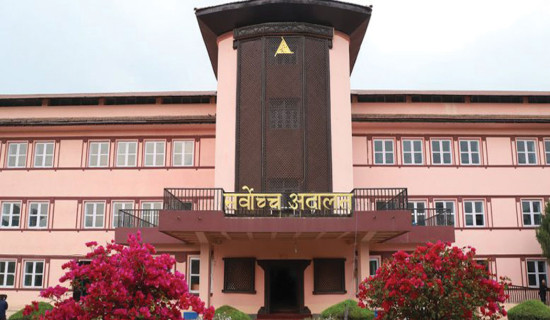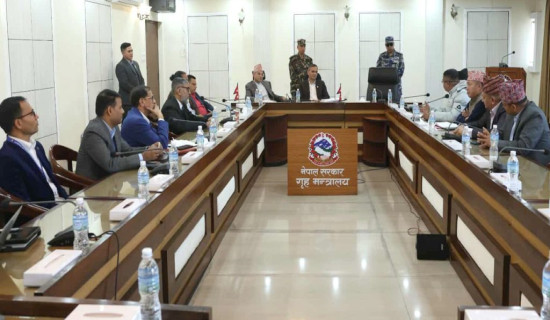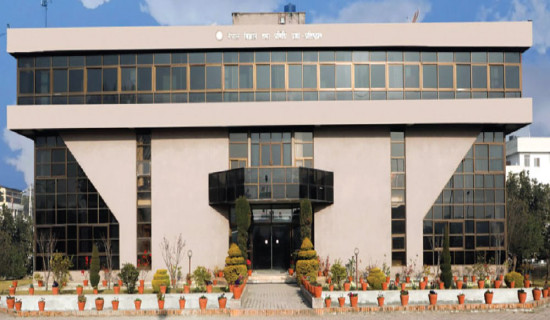- Thursday, 13 November 2025
Work On Reconstruction Roadmap
Though the three-tier governments have been making every effort possible for the distribution of relief to the survivors of the 6.4-magnitude Jajarkot earthquake, many are still waiting for relief materials. With the chilly winter about to set in, they are in urgent need of tents, tarpaulins, blankets, warm cloths, and foodstuff. The devastating quake that occurred on the night of November 3, with its epicentre at Ramidanda of Barekot Rural Municipality in Jajarkot district, has left more than 150 people dead and 200 others injured in Jajarkot and neighbouring Rukum West. The disaster has rendered thousands of people homeless with the destruction of their houses.
Preliminary data unveiled recently by the provincial disaster management centre under the Internal Affairs and Law Ministry in Karnali Province shows that the quake has caused damage to more than 20,000 houses in Jajarkot and Rurkum West. In Jajarkot alone, the number of physical structures suffering complete and partial damages stands at 8,336. In Rukum West, a total of 11,788 structures have been damaged. Even the partially razed houses are uninhabitable with the quake-hit areas recording aftershocks frequently. The tremor may have caused damage to more houses in the Karnali Province as it has affected 11 more districts. However, efforts are still being made to prepare a detailed assessment report on damages caused by the earthquake.
Schools damaged
The disaster has also destroyed numerous academic institutions, health facilities and police posts in Jajarkot and Rukum West. As many as 208 school buildings have been demolished. A total of 45 health institutions and 39 area police offices have been reduced to rubbles in those districts. These health institutions and police posts are now delivering their services to the people from tented make-shifts. As more people are reported to have suffered from various illnesses with the start of the cold season, it has been difficult for hospitals and other health facilities to serve patients.
What is dismaying is that five people have recently died of pneumonia and other respiratory problems in Jajarkot. This has sounded the alarm that the situation in the quake-affected areas may worsen if necessary steps are not taken in time to provide safer shelter to the needy. Children, elderly persons, pregnant women and those with underlying health conditions are very vulnerable to various diseases, including cold-related ailments. The traumatised quake survivors are also in need of counseling as they have lost their near and dear ones.
With Tihar and Chhat holidays now over, it is time for schools to reopen. But because of lack of classrooms, it is quite challenging for schools to run teaching-learning activities. The authorities concerned now need to pay an urgent attention towards building temporary classrooms so as to resume classes. When such facilities are not created immediately, the children’s education will be disrupted, leaving them in the lurch.
Over the years, the people of Barekot and adjacent areas have continued to face disasters of one form or the other. It is the same area where diarrhea had broken out about 14 years back. The epidemic had taken its toll on many people of Nalgad and other surrounding areas. As many as 356 people had lost their lives to diarrhea in Jajarkot alone. The area also witnessed the outbreak of swine-flu in 2015. The viral disease also killed some locals. Malnutrition, contaminated drinking water, rampant poverty and a lack of public awareness about health, hygiene and sanitation were some of the factors leading them to the epidemics and other natural disasters.
Following the earthquake, President Ram Chandra Paudel, Prime Minister Pushpa Kamal Dahal ‘Prachanda’, other ministers and high-level bureaucrats have inspected the disaster-affected areas. They have instructed the responsible authorities to concentrate efforts on carrying out rescue, relief and rehabilitation. The federal government has lately decided to provide Rs. 50,000 to each of the families whose house has been damaged for constructing a temporary shelter. It has also promised to give Rs. 200,000 as relief to each of the households losing a member in the earthquake. Different political parties have also mobilised their leaders and cadres to extend necessary support to the quake survivors. The parties have also expressed their commitment to constructing temporary shelters for the disaster-hit. Instead of competing with one another, they must work in close coordination and collaboration for taking the quake survivors out of traumas and pains.
Meanwhile, an all-party mechanism will be formed and mobilised at the local body and ward coordination in task of constructing temporary shelters and dealing with other issues. The Ministry of Urban Development will extend technical support for the construction of temporary shelters through the technicians of the respective local bodies. The government has also asked the provincial government to provide the human resources to monitor the construction of temporary shelters and mobilisation of technicians. The tremor-affected people should be hired for reconstruction as they are in need of a job.
Appeal for support
Amid a budget crunch for post-quake rehabilitation and reconstruction, the federal government has taken a decision to divert Rs. 8.25 billion allocated for the Parliamentary Constituency Infrastructure Development Programme for the fiscal year 2023-24 to the Disaster Management Fund. The government aims to spend this budget on rehabilitation and rebuilding. Besides, the Ministry of Finance will release Rs. 1.75 billion for the Disaster Management Fund. Since this amount is not sufficient for this task, the government has appealed to individuals, organisations, and international community to provide it with financial assistance for the purpose of post-quake recovery and reconstruction. The nation requires more resources for this. The government also needs to develop a legal and institutional mechanism for carrying out the task of reconstruction, ensuring that earthquake-resilient houses and other infrastructures are constructed at the earliest possible.
(The author is a freelancer.)









-original-thumb.jpg)






